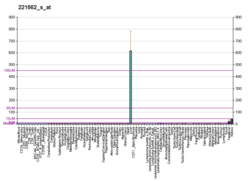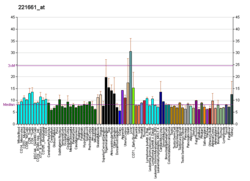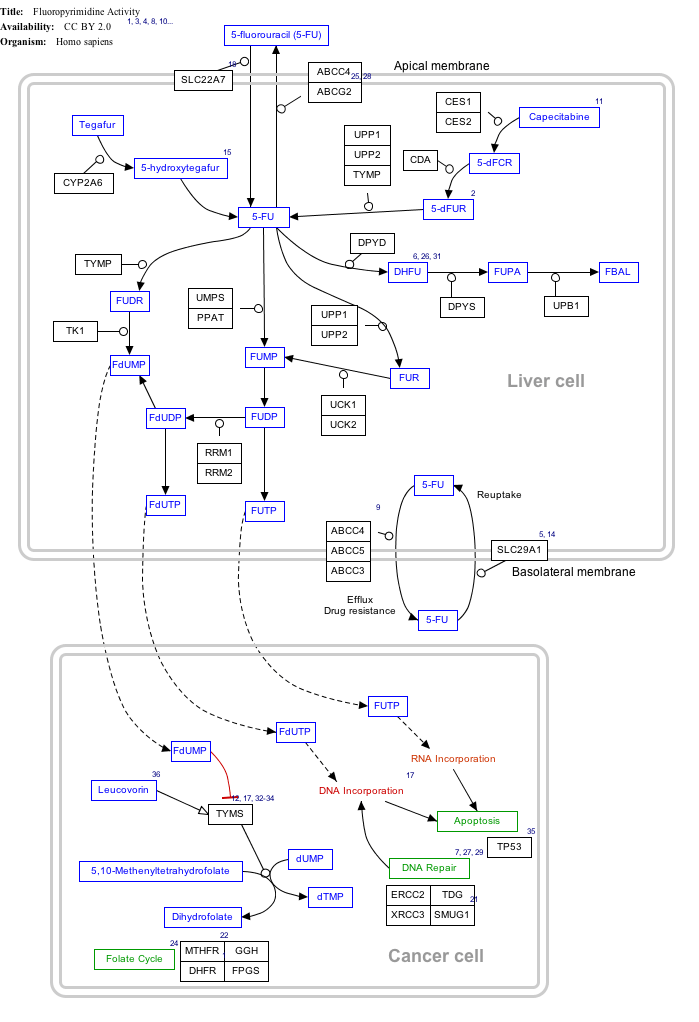SLC22A7
Solute carrier family 22 member 7 is a protein that in humans is encoded by the gene SLC22A7.[5][6][7]
The protein encoded by this gene is involved in the sodium-independent transport and excretion of organic anions, some of which are potentially toxic. The encoded protein is an integral membrane protein and appears to be localized to the basolateral membrane of the kidney. Alternatively spliced transcript variants encoding different isoforms have been described.[7]
Interactive pathway map
Click on genes, proteins and metabolites below to link to respective articles.[§ 1]
Fluorouracil (5-FU) Activity edit
- The interactive pathway map can be edited at WikiPathways: "FluoropyrimidineActivity_WP1601".
gollark: Many people such as citrons appear to have internalised the relevant meme complices.
gollark: We defined apioforms very clearly on certain websites.
gollark: Direct neural interface download generally works.
gollark: You just don't *get* apioforms.
gollark: Did you finish Infinity Train yet?
See also
- SLC22A7+protein,+human at the US National Library of Medicine Medical Subject Headings (MeSH)
References
- GRCh38: Ensembl release 89: ENSG00000137204 - Ensembl, May 2017
- GRCm38: Ensembl release 89: ENSMUSG00000067144 - Ensembl, May 2017
- "Human PubMed Reference:". National Center for Biotechnology Information, U.S. National Library of Medicine.
- "Mouse PubMed Reference:". National Center for Biotechnology Information, U.S. National Library of Medicine.
- Sekine T, Cha SH, Tsuda M, Apiwattanakul N, Nakajima N, Kanai Y, Endou H (Jul 1998). "Identification of multispecific organic anion transporter 2 expressed predominantly in the liver". FEBS Lett. 429 (2): 179–82. doi:10.1016/S0014-5793(98)00585-7. PMID 9650585.
- Kok LD, Siu SS, Fung KP, Tsui SK, Lee CY, Waye MM (Jun 2000). "Assignment of liver-specific organic anion transporter (SLC22A7) to human chromosome 6 bands p21.2→p21.1 using radiation hybrids". Cytogenet Cell Genet. 88 (1–2): 76–7. doi:10.1159/000015489. PMID 10773670.
- "Entrez Gene: SLC22A7 solute carrier family 22 (organic anion transporter), member 7".
Further reading
- Cropp CD, Komori T, Shima JE, et al. (2008). "Organic anion transporter 2 (SLC22A7) is a facilitative transporter of cGMP". Mol. Pharmacol. 73 (4): 1151–8. doi:10.1124/mol.107.043117. PMC 2698938. PMID 18216183.
- Kimura K, Wakamatsu A, Suzuki Y, et al. (2006). "Diversification of transcriptional modulation: large-scale identification and characterization of putative alternative promoters of human genes". Genome Res. 16 (1): 55–65. doi:10.1101/gr.4039406. PMC 1356129. PMID 16344560.
- Strausberg RL, Feingold EA, Grouse LH, et al. (2003). "Generation and initial analysis of more than 15,000 full-length human and mouse cDNA sequences". Proc. Natl. Acad. Sci. U.S.A. 99 (26): 16899–903. doi:10.1073/pnas.242603899. PMC 139241. PMID 12477932.
- Enomoto A, Takeda M, Shimoda M, et al. (2002). "Interaction of human organic anion transporters 2 and 4 with organic anion transport inhibitors". J. Pharmacol. Exp. Ther. 301 (3): 797–802. doi:10.1124/jpet.301.3.797. PMID 12023506.
- Kimura H, Takeda M, Narikawa S, et al. (2002). "Human organic anion transporters and human organic cation transporters mediate renal transport of prostaglandins". J. Pharmacol. Exp. Ther. 301 (1): 293–8. doi:10.1124/jpet.301.1.293. PMID 11907186.
- Babu E, Takeda M, Narikawa S, et al. (2002). "Human organic anion transporters mediate the transport of tetracycline". Jpn. J. Pharmacol. 88 (1): 69–76. doi:10.1254/jjp.88.69. PMID 11855680.
- Sun W, Wu RR, van Poelje PD, Erion MD (2001). "Isolation of a family of organic anion transporters from human liver and kidney". Biochem. Biophys. Res. Commun. 283 (2): 417–22. doi:10.1006/bbrc.2001.4774. PMID 11327718.
This article incorporates text from the United States National Library of Medicine, which is in the public domain.
This article is issued from Wikipedia. The text is licensed under Creative Commons - Attribution - Sharealike. Additional terms may apply for the media files.







